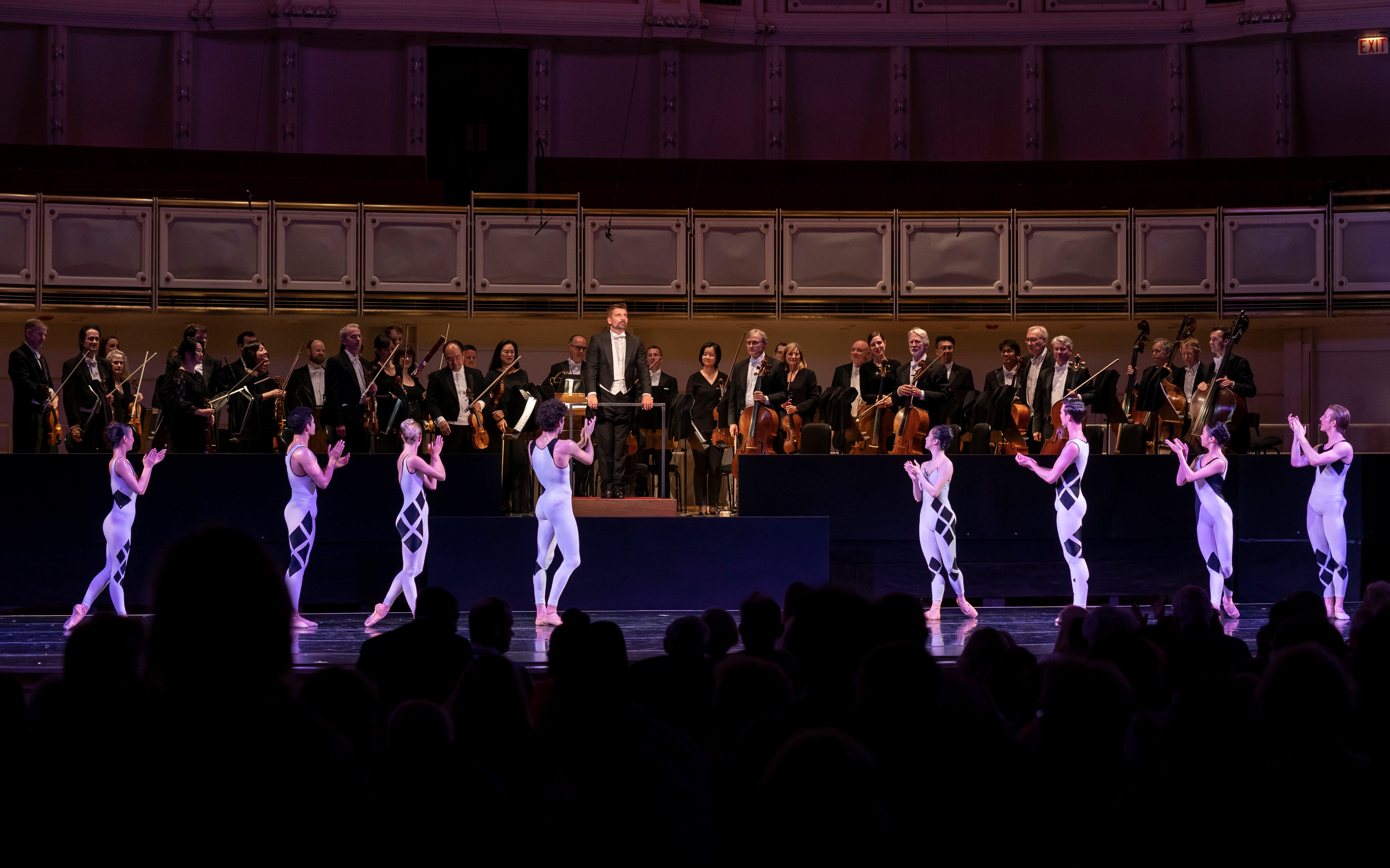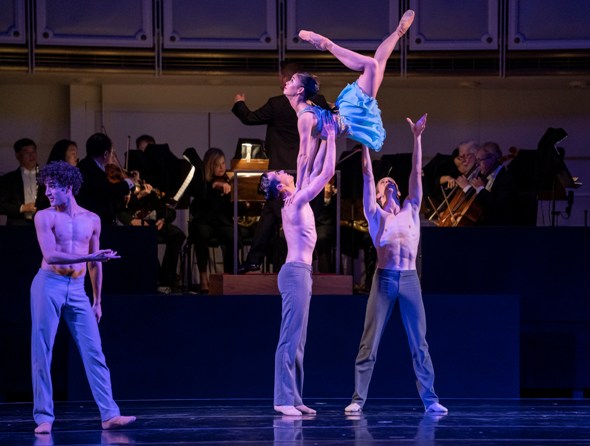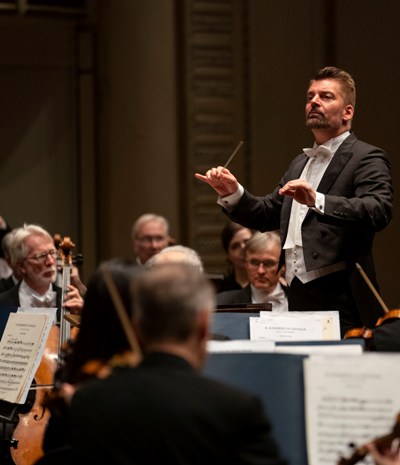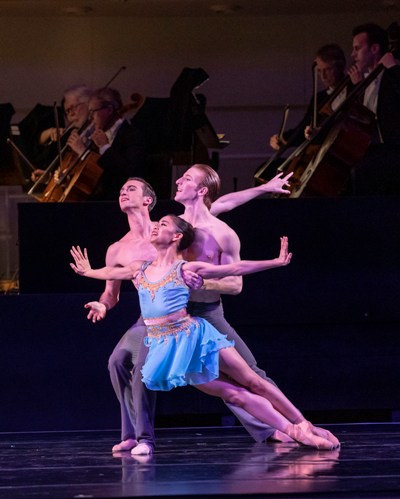Partnering of Chicago Symphony and Joffrey shows promise despite limits in staging ballet

Together at last, but stage logistics are a challenge: Chicago Symphony Orchestra and dancers of Joffrey Ballet in Christopher Wheeldon’s ‘Commedia,’ choreographed to Stravinsky’s ‘Pulcinella.’ (Concert photos by Todd Rosenberg)
Review: Chicago Symphony Orchestra and Joffrey Ballet in joint program onstage at Orchestra Hall, Matthias Pintscher conducting.
By Hedy Weiss
The idea of engaging in a bit of cross-cultural pollination of artists and audiences – as the Chicago Symphony Orchestra and the Joffrey Ballet are now doing in their first collaboration – makes perfect sense. After all, what could be better than the natural alliance between two of Chicago’s cultural crown jewels?
But through no fault of either the musicians or the dancers, the program that debuted May 30 at Symphony Center, didn’t quite work. The music (by Stravinsky and Ravel, with a brief nod to Rossini) was exquisite, and exquisitely played, with guest conductor Matthias Pintscher on the podium. And the dancers (something of a chamber company drawn from the full Joffrey roster) were lovely. But to get to the core of the matter: Symphony Center’s stage is simply a most unfelicitous venue for dance on many counts.

Edson Barbosa, Evan Boersma, Yumi Kanazawa, Stefan Goncalvez in the world premiere of ‘Bliss!,’ choreographed by Stephanie Martinez to music of Stravinsky’s “Dumbarton Oaks” Concerto.
To begin with, there are no wings or curtains, so entrances and exits must be made through a single doorway on either side of the stage. Second, while a special floor was laid, it was far from ideal and appeared somewhat slippery. Finally, there is the matter of lighting. Dance needs no scenery, but theatrical lighting is its invaluable partner. So the two pieces performed by the Joffrey looked more like dress rehearsals being done in a dance studio than fully supported ballets. The Auditorium Theatre or the Harris Theatre for Music and Dance would be far better choices for future collaborations – and I hope there will be many more.
That said, the musical aspects of the evening were magical, with the tall, graceful Pintscher, a student of Pierre Boulez who now serves as director of the Paris-based Ensemble Intercontemporain that Boulez founded, leading various configurations of the orchestra with clarity and precision, warmth and sparkle.
The first half of the program was all music, with a clever bit of programming by way of the opening piece, Rossini’s breathlessly exuberant and playfully dancing Overture to “The Barber of Seville.” Its mischievous spirit set the stage to come full circle for the final work of the evening, an homage to commedia dell’arte (a form of improvised comedy popular in Italy from the 16th through18th centuries) that is captured in the music of Stravinsky’s 1920 one-act ballet “Pulcinella,” and which choreographer Christopher Wheeldon has used for his harlequinade of a ballet, “Commedia.”
The main work in the first half of the concert was Ravel’s 1911 ballet score “Mother Goose,” an altogether enchanting sonic poem that makes brilliantly original use of the orchestra’s strings, winds and horns, as well as the “special effects” that can be generated by the harps and celesta, plus xylophone, glockenspiel, triangle and other percussion.
This work is an evocation of “Sleeping Beauty” and “Beauty and the Beast” as you will never hear it in a Disney movie. The overall effect created was one of a diaphanous, richly atmospheric curtain, with the suggestion of fairy tale fantasy shifting from an airy, suspended delicacy one moment to a spirited Oriental exoticism the next, and from natural bird-like sounds to a lush cinematic climax. Special applause for the superb work of flute Emma Gerstein, clarinet John Bruce Yeh and harp Sarah Bullen. The shimmering beauty of it all was an example of the CSO at its finest.
Dance was of the essence after intermission, with the orchestra reduced to a more chamber-like size and seated on a platform at the back of the stage.
First up was Stephanie Martinez’s “Bliss!,” a world premiere commission by the Joffrey Ballet set to Stravinsky’s three-movement, Bach-inspired 1938 Concerto in E-flat (“Dumbarton Oaks”).
Martinez, who has danced with and choreographed for many companies in Chicago and beyond, has created a quasi-neo-classical piece in the Balanchine mode, with a great deal of movement and extreme, acrobatic lifts that ultimately feel like a whole lot of steps in search of nothing in particular, including any deep insight into the music.
“Bliss!” begins promisingly enough with five bare-chested men in gray jersey pants (the fabulous Edson Barbosa, along with Evan Boersma, Stefan Goncalvez, Greig Matthews and Xavier Nunez) moving in a jagged line horizontal line that gradually deconstructs. They are variously joined by two women – the excellent Anais Bueno and Yumi Kanazawa, costumed in soft chiffon tutus, who are lifted, twisted, spun and tossed to exaggerated effect.
Barbosa is a supremely gifted dancer who also happens to be an extraordinary partner. His easy, confident lifts and sense of connection make every pas de deux stronger and more exciting, and he is particularly well-matched with Bueno, a dancer whose spirit is much like his.
Finally, “Commedia,” which Wheeldon choreographed in 2008, after which he proceeded to create several full-length ballets (including the Joffrey’s “Nutcracker”), plus a Broadway musical (“An American in Paris”). Wheeldon is clearly a man of the theater.
His ballet opens as eight different stock character types from the commedia tradition –dressed in costumes and masks full of flair and color by fashion designer Isabel Toledo – gather at the center of the stage. The dancers included Barbosa, paired with the stunning Gayeon Jung; the fleet Nunez with Yumi Kanazawa in a notably rapid-fire sequence; the elegant Brooke Linford, and Yuka Iwai, Boersma and Goncalvez. Much of the time the dancers were in white unitards emblazoned with iconic black, diamond-shaped patterns.
Wheeldon’s choreography is always musical, winningly flirtatious, rich in patterning, and full of elaborate lifts and other moves (not unlike those in Martinez’s piece).
As for the Stravinsky score, drawn from the music of Pergolesi, the early 18th century Italian composer, it is light-hearted, buoyant and infectious, and about as far away from “The Rite of Spring” as can be imagined.




